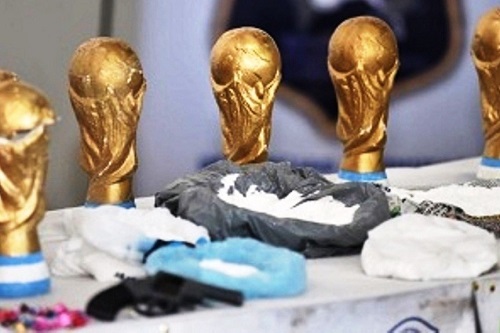GN photo
By
Ricardo Swire
The celebrated FIFA World Cup 2018 has been used by ultra-modern South American drug trafficking organizations as a camouflage to increase global cocaine shipments and distribution. Market prices vary and depend on location. Colombian dispatches to the USA, or cocaine’s biggest market, revolves around one kilo valued US$36,000 in Maryland, US$28,000 on Florida and California markets, US$26,000 “pure” plus US$22,000 high purity “re-rocked” California exclusive also available.
A kilo of white powder on the Virginia market averages US$16,000 and US$30,000 via the internet. In mid-June 2018 Argentine Federal Police antinarcotics officers assigned to La Matanzas, Buenos Aires, intercepted one and a half kilos of Colombian cocaine concealed in replica World Cup trophies. Two illegal .38 caliber revolvers were also seized. The six member local drug Cartel, from Isidro Casanova City in Greater Buenos Aires, used two vehicles for distributions around Argentina’s provincial subdivision.
On Friday June 22, 2018 uniformed Colombian antinarcotics officers, who inspect parcels traversing El Dorado International Airport to international destinations, intercepted fourteen replica Colombian national football/soccer uniform jerseys. The sports garments were saturated in cocaine hydrochloride or liquid cocaine and emitted a strange odor. The drug Cartel’s chemist used a scientific process that allowed alkaloid to dissolve and spread across the souvenir shirts’ fabric. A reversed chemical process extracts the liquid cocaine and transforms it to powder for distribution.
The evidence trail highlighted how fourteen imitation Colombian football/soccer jerseys were dispatched from Barranquilla city Northern Colombia, destined for Groningen in the Netherlands. The inspecting Colombian National Police officer used a “Narcotex Test” to confirm the shirts were soaked with invisible cocaine hydrochloride. After chemical conversion the liquid amount as powder weighted more than five kilos.
European trafficking patterns outline Rotterdam, or South Holland city’s largest port, as most popular cocaine transshipment point. A reputation established since the narco-traffickers counter-surveillance providers realized border security officials stationed at Rotterdam port only inspect one in every one hundred shipping containers. The Netherlands’ organized crime organizations in southern provinces North-Brabant and Limburg are Europe’s main and largest producer/supplier of marijuana, MDMAs and amphetamines.
Dutch underworld extensions based on the Caribbean’s ABC islands or Aruba, Bonaire and Curacao, manage warehouse and transfer facilities for product en-route to America and Europe. One of Aruba’s Queen Beatrix Airport Deputy Director reports confirmed the island’s Lesser Antilles geographical position, plus distance from Colombia and Venezuela, made it the premier choice for traffickers’ secret meetings and logistics operations.
Aruba’s fifty miles of coastline, plus six unofficial airstrips, accommodate the South American cocaine movements. Human drug mules travel from Bogota to Aruba aboard commercial airline flights. South American cartels also exploit Aruba’s sister island Curacao’s lax regulations with creative money laundering schemes. A 2016 US State Department report noted Curacao’s official investigations of a local mega lottery operator, a former Prime Minister (PM), plus a Member of Parliament (MP), for money laundering crimes.
Ricardo Swire
Ricardo Swire is the Principal Consultant at R-L-H Security Consultants & Business Support Services and writes on a number of important issues.



No Comments Yet!
You can be first to comment this post!